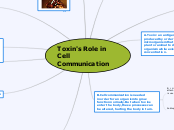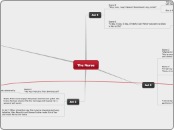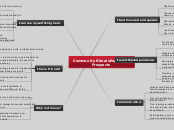Final Concept Map
Cell Communication
Name the character
Type in the name of the character whose change throughout the story you are going to analyze.
Example: Nick Carraway.
Tyrosine Kinase Pathways
Character's behavior
Think of the character's behavior at the beginning of the story and look for the way it changed throughout the story.
Tyrosine Kinase reception
When the phosphate groups are added to Tyrosines, the activated receptor can now interact with other proteins to bring about a response from the cell.
Each polypeptide on dimerization functions as a kinase, taking phosphate groups from ATP and adds it to the other polypeptide.
This is called autophosphorylation!
The Tyrosine Kinase receptor is made of two polypeptides which dimerize when a signal molecule is bound to each polypeptide.
Each polypeptide has the ability to function as a kinase (an enzyme that adds phosphate groups to something).
G Protein Signaling Pathways
Character's feelings
Focus on the way the character's feelings are presented at the beginning and at the end of the story, while explaining why they have changed.
cAMP asca Second Messenger
5
Finally, cAMP, as a second messenger, activates another protein, leading to cellular responses.
cAMP jump starts the signal transduction cascade!
4
The now activated adenylyl cyclase
converts ATP to cAMP.
How does a cell make ATP?
2. Oxidative Phosphorylation
Energy is used to add a Pi (inorganic
phosphate) to ADP to form ATP
1. Substrate-Level Phosphorylation
(can be attained through glycolysis
and the citric acid cycle)
A substrate that contains a phosphate group binds to the active site on an enzyme.This causes the phosphate group to bind to ADP (Adenosine diphosphate).
In the end,there will be a product and a
molecule of ATP (Adenosine triphosphate).
3
Later, the activated G protein (bound to GTP) binds to adenylyl cyclase.
GTP is then hydrolyzed,
activating adenylyl cyclase.
Then, the sub-activated GPCR binds to the G protein, which is then bound by GTP, activating the G protein.
The transduction process starts off with a relay molecule, or second messengers, which carry the message from the signal inside the cell.
The first messenger binds to
GPCR, activating it.
G-protein coupled reception
2
The activating change in the GPCR, as well as the changes in the G protein and enzyme, are only temporary.
These molecules soon become available for reuse.
Once activated, the enzyme can trigger the next step leading to a cellular response.
Binding of signaling molecules is reversible!
The activated G protein leaves the receptor, diffuses along the membrane, and then binds to an enzyme, altering the enzyme’s shape and activity.
1
Finally, the activated G
protein carries a GTP molecule.
Now, the active G protein can activate a nearby enzyme.
Its cytoplasmic side then binds and activates a G protein.
The activation of the G protein is due to the replacement of GDP to GTP.
Cells
Euckaryotes
Plant Cell
Mitochondria
Golgi apparatus
Peroxisome
Plasma membrane
Cytoskeleton
Central vacuole: prominent in older plants; its functions include storage, breakdown of waste products, and hydrolysis of macromolecules; its enlargement is a major mechanism for plant growth
Ribosomes
Endoplasmic Reticulum
Cell wall: outer layer of cell that protects cell from mechanical
damage; made of cellulose, other polysaccharides, and protein
Plasmodesmata:cytoplasmic channels through cell walls that
connect the cytoplasms of adjacent cells
Chloroplast:converts energy from sunlight to chemical energy
stored in sugar molecules
Animal Cell
Flagellum:Helps with cell movement
Centrosome:Before cell division, the centrosome duplicates and then, as division begins, the two centrosomes move to opposite ends of the cell.
Golgi apparatus: Is made of different sacs one side receives material from the ER where the other side changes it and ships it off.Subtopic
lysosomes: Membrane bound organelles filled with enzymes. These enzymes promote hydrolysis which is used to break covalent bonds
Mitochondria: Produces most energy needed to make the cell function and stores this energy in ATP
Peroxisomes: An oxygen rich membrane bound organelle
Endoplasmic rectum: takes up almost more than half of the membrane attached to the nuclear envelope
Rough ER: bound ribosomes, secretes glycoproteins, distributes transport vesicles, MEMBRANE FACTORY
Subtopic
Smooth ER :Lacks ribosomes,synthesizes lipids, metabolises carbohydrates, stores calcium ions and detoxifies poisons
Ribosomes: Made of ribosomal RNA and proteins in charge of making proteins and is located in 2 locations the cytosol (free ribosomes), and outside the ER (bound ribosomes)
Nucleus
Chromatin: The DNA and proteins of chromosomes, helps in cell division.
Nucleolus: Nonmembranous and helps produce ribosomes.
Nuclear Envelope: A double membrane regulating what comes in and out the nucleus. This Envelope is lined with nuclear pore that are lined with proteins that allow transport in and out of the nuclease.
Plasma Membrane
Vessciles
Receptors
Microvilli: increase the surface area for diffusion and minimize any increase in volume, and are involved in a wide variety of functions, including absorption, secretion, cellular adhesion, and mechanotransduction.
Cytoskeleton: Helps the cell keep shape and assists with movement
Microtubules: Proteins in the cytoskeleton
microfilaments:Proteins in the cytoskeleton
Intermediate Filaments
Archaea
RNA polymerase:
Membrane Lipids:
Plasmid:
Fimbriae and Phili: Attachment to surfaces and bacterial mating
Cytoplasm:
Flagella: Movement
these are nonhomologous
Ribosomes: Protein synthesis
Cell Wall:
Archaea do not contain peptidoglycan in their cell wall
Plasma Membrane:
The cell membrane in archaea, it can be a lipid bilayer or a monolayer, they also contain phytanyl – archaeal phospholipids differ from those found in Bacteria and Eukaryotes, they have branches phytanyl side-chains instead of linear ones as well as an ether bond instead of an ester bond that connects the lipid to the glycerol.
Bacteria
Capsule: many bacterial cells secrete extracellular material in the form of a capsule or. slime layer. It is attached tightly to the bacterium and has definite boundaries.
capsules are usually polymers of simple sugars
Plasmid: a small, circular, double-stranded DNA molecule that is distinct from a cell's chromosomal DNA. They naturally exist in bacterial cells (some eukaryotes). They provide bacteria with genetic advantages.
Cytoplasm: is a thick solution that fills each cell and is enclosed by the cell membrane. It is mainly composed of water, salts, and proteins.
Fimbriae and Pili: Fimbriae are short hair like projections located on the surface of bacteria, they are used to stick to the substrate or to each other (bacteria). Some bacteria also contain long projections called pili which are involved in forming a channel between 2 bacterial cells to transfer DNA from one cell to the other.
Flagella: microscopic hair-like structures involved in the locomotion of a cell. They help to propel a cell through the liquid. Some can even sense changes in pH and temperature. They are coiled, thread-like type structure
Nucleoid: where genetic information is found, it has no membrane surrounding it. It attaches to the cell membrane and in immediate contact with the cytoplasm. It essentially controls the activity of the cell and reproduction.
Ribosomes: a complex of RNA and protein, they assemble amino acid to form proteins that are essential to carry out cellular functions. The DNA produces mRNA by the process of DNA transcription. (They are specialized cell organelles found in both prokaryotic and eukaryotic cells.)
Cell Wall: a protective layer that surrounds some cells and gives them shape and rigidity. It is located outside the cell membrane and prevents osmotic lysis.
Bacteria contain peptidoglycan in the cell wall, which are coposed of polysaccharide chains that are cross-linked by unusual peptides
Plasma Membrane: a thing lipid bilayer that surrounds the cell and separates the inside from the outside.
The cell membrane in bacteria is a lipid bilayer and they also contain fatty acids
Transcription and Translation
Membrane Proteins
Gap Junction Proteins: a direct connection between the cytoplasm of two cells, which allows various molecules and ions to pass freely between cells
Ion channels and Gates: the flow of ions across the cell membrane
Glucose Permease: the reversible transporter protein of glucose
Na+/K+ ATPase: responsible for establishing and maintaining the electrochemical gradient of Sodium and Potassium ions across the plasma membrane
Glycoprotein: cell-to-cell interactions
DNA Structure
Endomembrane System
Proteins made on the free ribosomes can generally either enter the endomemebrane system by first going to the E.R. or they can go to other cell organelles (mitochondria, nucleus, peroxisomes, chloroplast - plant cell).
Protein Destinations
Secretory Pathway: path taken by a protein in a cell on synthesis to modification and then release out of the cell (secretion). There exist many pathways as well as exceptions.
Translation
At Initiation, small ribosome subunit initiator tRNA carrying Met of f-Met scan the mRNA to find the start codon. The large subunit then joins this complex to form a translation initiation complex
Initiation: brings together mRNA, tRNA bering the first amino acid of the polypeptide and 2 subunits of ribosome (assembly of this complex needs GTP). The small ribosomal subunit along with the tRNA fist bind the 5' cap, scans mRNA to find the first AUG (Methionine). Then the large ribosomal subunit comes along to form a transition initiation complex. The first tRNA carrying Methionine is at the P-site.
Elongation: this stage begins when the next tRNA carrying the correct amino acid comes to the A-site. A peptide bond forms between the two amino acids. Thus, the enzyme that forms the peptide bonds is called, Peptidyl Transferase. The tRNA that is now empty in the P-site moves to the E-site to be released while the tRNA from site-A moves to site-P and a new tRNA comes to the A-site. The mRNA is read in 5' to 3' direction while the amino acids are added from N to C direction.
Termination: Once a STOP codon is reached in the A-site there is no tRNA that corresponds to a stop codon. Instead, a Release Factor sits in the A-site, dissociating the complex stopping translation (this is a GTP driven process).
The ribosome has three sites: The A-site is the entry site for new tRNA charged with amino-acid or aminoacyl-tRNA. The P-site is occupied by peptidyl-tRNA - the tRNA that carries the growing polypeptide
chain. The E-site is the exit site for the tRNA after it's done delivering the amino
At the same time, the ribosome moves one triplet forward on the mRNA. As a result, the empty tRNA is now in the E-site and the peptidyl tRNA is in the P-site. The A-site is now empty and is ready to accept a new tRNA. The cycle is repeated for each codon on the mRNA.
Initiation: The small ribosomal subunit is separated from the large subunit with the help of IF1 and IF3. This complex then binds to the purine-rich region known as Shine-Dalgarno sequence. This alignment ensures that the start codon is in the right position within the ribosome. Another initiation factor, IF2, brings in the initiator tRNA charged with the initiator amino acid N-formyl-methionine. The large ribosomal subunit joins the complex and all initiation factors are released.
Elongation: Elongation follows when a new tRNA carrying an amino acid enters the A-site of the ribosome. On the ribosome, the anticodon of the incoming tRNA is matched against the mRNA codon positioned in the A-site. When the right aminoacyl-tRNA enters the A-site, a peptide bond is made between the two now-adjacent amino-acids. As the peptide bond is formed, the tRNA in the P-site releases the amino-acids onto the tRNA in the A-site and becomes empty.
Termination: Termination happens when one of the three stop codons is positioned in the A-site. Since no tRNA can fit in the A-site at that point because there are no tRNA that match the sequence, the codons are recognized by a release factor. When the binding of the release factor catalyzes the cleavage of the bond between the polypeptide and the tRNA, the polypeptide is released from the ribosome, which is later disassociated into subunits and is ready for a new round of translation.
Transcription
Eukaryotes
Initiation:
In order for initiation to begin,
eukaryotes require transcription factors.
The transcription factors will bind to the
promoter sequence in order to allow RNA
polymerase II to bind.
Elongation:
During elongation, RNA polymerase II
is attached to the +1 nucleotide. From
there, it will begin the synthesis of the
new RNA strand in the 5' to 3' direction.
The new nucleotides will be added to the
3' end of the growing RNA strand.
Termination:
The sequence AAUAAA signals the cell
to make a cut in the pre-mRNA and
release it from the DNA. Then, a modified
G nucleotide (CAP) is added to the 5' end
of the pre-mRNA. Meanwhile, a poly-a tail
is added o the 3' end of the pre-mRNA by
an enzyme called poly-A polymerase.
RNA Splicing:
During RNA splicing, the introns
in the pre-mRNA are removed so
that the exons can be joined
together. Spliceosomes are
responsible for the removal of
the introns. The ending result of
this process is mRNA.
Prokaryotes
At the -10 and -35 regions upstream of the initiation site, there are two promoter consensus sequences: the 10 region is TATAAT, while the -35 sequence TTGACA, is recognized and bound by σ. The transcription initiation phase ends with the production of abortive transcripts.
Initiation: Transcription of mRNA in prokaryotes begins at the initiation site, where the DNA molecule unwinds and separates to form a small open complex. RNA polymerase binds to the promoter of the template strand.
Elongation: The elongation phase begins with the release of the σ subunit from the polymerase, allowing the core RNA polymerase enzyme to proceed along the DNA template, synthesizing mRNA in the 5′ to 3′ direction.
Termination: There are two ways in which transcription is terminated: In Rho-dependent termination, a protein factor called "Rho" is responsible for disrupting the complex involving the template strand, RNA polymerase and RNA molecule. In Rho-independent termination, a loop forms at the end of the RNA molecule, causing it to detach itself.
RNA Splicing: Splicing is an extremely rare event that occurs only in non-coding RNAs, such as tRNAs.
Gene Regulation
Repressors
Repressors are created during transcription. They are specific transcription factors that turn off the cell when they enter it.
Repressors can stop the transcription process
or it can reduce the level of transcription if it is too high.
Repressor proteins help to cease the transcription process by binding to the enhancer. This causes RNA polymerase II to lose the ability to efficiently bind to the promoter, therefore, reducing transcription.
Prokaryotic Genes
Gene Regulation happens in the Transcription stage of gene expression
In prokaryotes genes are organized in gene groups called operons. Some operons preform specific tasks such as the operator(switch)
Activators or repressors( proteins that bond to the operator) control positive or negative regulation of genes
The LAC operon has positive and negative regulation such that all operons code for either positive regulation negative regulation or both such as LAC.
Transcription factors
Activators
Activators are created during transcription. They are specific transcription factors that turn on the cell when they enter it.
Activators can allow the transcription process to continue
or it can increase the level of transcription.
Activators are brought into contact with a group of mediator proteins through DNA bending. Then, the protein-protein interactions between the mediator and promoter proteins help to assemble and position the initiation complex on the promoter. This interaction helps RNA polymerase II to bind efficiently to the promoter increasing transcription rates to above basal levels.
Cells control which gene is expressed in a certain part of the body through combinatorial control of gene expression. An example is the liver cell, where activator proteins are present that bind to the enhancer sequences that increase expression of albumin gene. But no activator proteins are present that bind enhancer for crystallin gene (which can be found in the eye cells). In the liver cell, albumin gene has increased expression, while crystallin gene has basal (or background) expression.
Eukaryotic Genes
Once the protein is made it needs o be folded correctly and transported to the correct location in the cell. If a cell doesn't need a functional protein, all possible steps must be viewed to see which can be blocked, thus the functional protein is not made or if it is made it doesn't reach its destination.
Most common step for this is the control at the level of transcription.
Transcription factors have t first bind the promoter then RNA pol II can bind. It's these transcription factors that help regulate/control transcription.
*In transcription we form pre-mRNA which is then processed to form mRNA* Associated with most eukaryotic genes are multiple control elements. These segments of noncoding DNA serve as binding sites for transcription factors that help regulate transcription. Control elements and the transcription factors they bind are critical for precise regulation of gene expression in different cell types.









